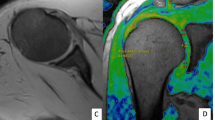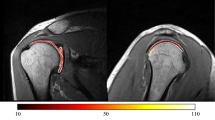Abstract
The evaluation of articular cartilage currently relies primarily on the identification of morphological alterations of the articular cartilage. Unlike anatomic imaging, T2 mapping is sensitive to changes in the chemical composition and structure of the cartilage. Clinical evaluation of T2 mapping of the glenohumeral joint has not been previously reported. The objectives of this study were to evaluate the feasibility of magnetic resonance T2 mapping of the glenohumeral joint in routine clinical imaging, to assess the normal T2 mapping appearance of the glenohumeral joint, and to compare the findings on T2 maps to conventional MR pulse sequences. Magnetic resonance imaging (MRI) examinations of 27 shoulders were performed in a routine clinical setting. All studies included acquisition of T2 mapping using a dedicated software. The T2 maps were analyzed along with the routine MR exam and correlation of cartilage appearance on T2 map and on conventional MR sequences. T2 imaging maps were obtained successfully in all patients. T2 maps and routine MRI correlated in cases of normal cartilage and prolonged T2 values and cartilage defects. In four cases, increased T2 relaxation times in the cartilage and cartilage defects were more apparent on T2 maps. Acquisition of T2 maps at the time of routine MRI scanning is feasible and not time-consuming.





Similar content being viewed by others
References
McCauley TR, Recht MP, Disler DG (2001) Clinical imaging of articular cartilage in the knee. Semin Musculoskelet Radiol 5:293–304
Recht M, White LM, Winalski C et al (2003) MR imaging of cartilage repair procedures. Skeletal Radiol 32:185–200
Lazovic-Stojkovic J, Mosher TJ, Smith HE, Yang QX, Dardzinski BJ, Smith MB (2004) Interphalangeal joint cartilage: high-spatial-resolution in vivo MR T2 mapping—a feasibility study. Radiology 233:292–296
White LM, Sussman MS, Hurtig M, Probyn L, Tomlinson G, Kandel R (2006) Cartilage T2 assessment: differentiation of normal hyaline cartilage and reparative tissue after arthroscopic cartilage repair in equine subjects. Radiology 241:407–414
Mosher TJ, Dardzinski BJ (2004) Cartilage MRI T2 relaxation time mapping: overview and applications. Semin Musculoskelet Radiol 8:355–368
Zaim S, Lynch JA, Li J, Genant HK, Peterfy CG (2001) MRI of early cartilage degeneration following meniscal surgery: a three-year longitudinal study. Proc Int Soc Mag Reson 9:76
Gray ML, Burstein D, Xia Y (2001) Biochemical (and functional) imaging of articular cartilage. Semin Musculoskelet Radiol 5:329–343
Gold G, Beaulieu C (2001) Future of MR imaging of articular cartilage. Semin Musculoskelet Radiol 5:313–327
Glaser C (2005) New techniques for cartilage imaging: T2 relaxation time and diffusion weighted MR imaging. Radiol Clin North Am 43:641–653
Spandonis Y, Heese FP, Hall LD (2004) High resolution MRI relaxation measurements of water in the articular cartilage of the meniscectomized rat knee at 4.7 T. Magn Reson Imaging 22:943–951
Dunn TC, Lu Y, Jin H, Ries MD, Majumdar S (2004) T2 relaxation time of cartilage at MR imaging: comparison with severity of knee osteoarthritis. Radiology 232:592–598
Maier CF, Tan SG, Hariharan H, Potter HG (2003) T2 quantitation of articular cartilage at 1.5 T. J Magn Reson Imaging 17:358–364
Smith HE, Mosher TJ, Dardzinski BJ et al (2001) Spatial variation in cartilage T2 of the knee. J Magn Reson Imaging 14:50–55
Dardzinski BJ, Mosher TJ, Li S, Van Slyke MA, Smith MB (1997) Spatial variation of T2 in human articular cartilage. Radiology 205:546–550
Dardzinski BJ, Laor T, Schmidthorst VJ, Klosterman L, Graham TB (2002) Mapping T2 relaxation time in the pediatric knee: feasibility with a clinical 1.5-T MR imaging system. Radiology 225:233–239
Mosher TJ, Dardzinski BJ, Smith MB (2000) Human articular cartilage: influence of aging and early symptomatic degeneration on the spatial variation of T2—preliminary findings at 3 T. Radiology 214:259–266
Frank LR, Wong EC, Luh WM, Ahn JM, Resnick D (1999) Articular cartilage in the knee: mapping of the physiologic parameters at MR imaging with a local gradient coil—preliminary results. Radiology 210:241–246
Link TM, Stahl R, Woertler K (2007) Cartilage imaging: motivation, techniques, current and future significance. Eur Radiol 17:1135–1146
Disler DG, Recht MP, McCauley TR (2000) MR imaging of articular cartilage. Skeletal Radiol 29:367–377
Guermazi A, Zaim S, Taouli B, Miaux Y, Peterfy ChG, Genant HK (2003) MR findings in knee osteoarthritis. Eur Radiol 13:1370–1386
Duvvuri U, Kudchodkar S, Reddy R, Leigh JS (2002) T(1rho) relaxation can assess longitudinal proteoglycan loss from articular cartilage in vitro. Osteoarthritis Cartilage 10:838–844
Bashir A, Gray ML, Boutin RD, Burstein D (1997) Glycosaminoglycan in articular cartilage: in vivo assessment with delayed Gd-(DTPA)(2-)-enhanced MR imaging. Radiology 205:551–558
Harrison R, Bronskill MJ, Henkelman RM (1995) Magnetization transfer and T2 relaxation components in tissue. Magn Reson Med 33:490–496
Packer KJ (1977) The dynamics of water in heterogeneous systems. Philos Trans R Soc Lond B Biol Sci 278:59–87
Henkelman RM, Stanisz GJ, Kim JK, Bronskill MJ (1994) Anisotropy of NMR properties of tissues. Magn Reson Med 32:592–601
Acknowledgments
Authors graciously thank MRI technologists of St. Paul’s Hospital and Monika Ferrier, BA for their important and enthusiastic help.
Author information
Authors and Affiliations
Corresponding author
Rights and permissions
About this article
Cite this article
Maizlin, Z.V., Clement, J.J., Patola, W.B. et al. T2 Mapping of Articular Cartilage of Glenohumeral Joint with Routine MRI Correlation—Initial Experience. HSS Jrnl 5, 61–66 (2009). https://doi.org/10.1007/s11420-008-9106-3
Received:
Accepted:
Published:
Issue Date:
DOI: https://doi.org/10.1007/s11420-008-9106-3




